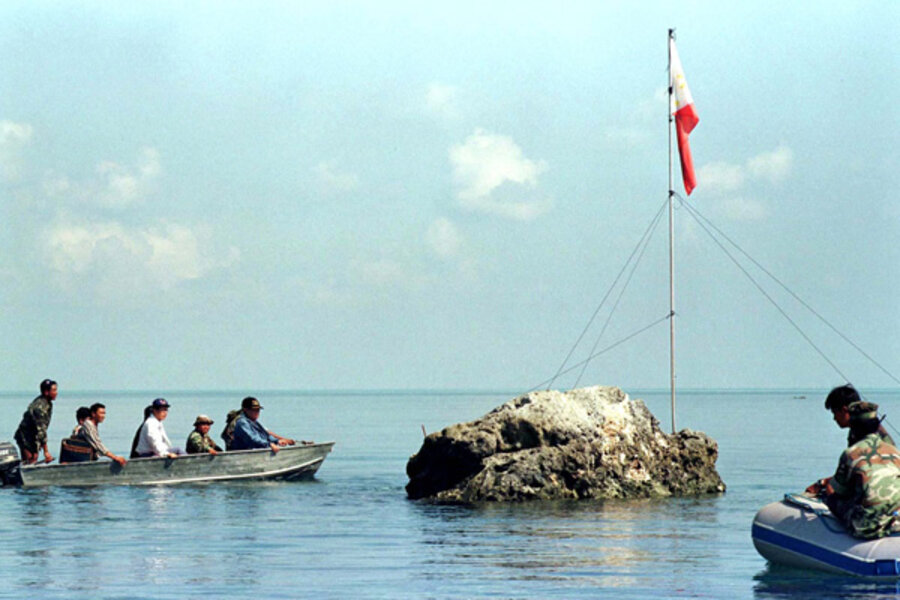China and Philippines pull back from sea dispute
Loading...
| Taipei, Taiwan
A calm after two months of extreme tension between China and the Philippines over rights to a strategically important sea area is giving both sides room to reevaluate foreign policy and size up the US role in the dispute before deciding any next moves.
Both governments say ships have left Scarborough Shoal, a disputed coral reef at the epicenter of the tensions between the two countries 143 miles west of the main Philippine island of Luzon. The Philippine foreign ministry said that “following consultations,” two Chinese ships and one of its own fisheries agency vessels had pulled out from a lagoon near the shoal.
Though some reports said both sides left because of typhoon season, the departures ease severe tension that had mounted from April, when the Philippines tried to arrest the crews of eight Chinese fishing boats. Still, the pullback doesn’t mean the Manila-Beijing dispute is over: US support of its longtime ally the Philippines also shows signs of consolidating, and future trouble could pit the world’s top two superpowers against one another.
“Any time we see a US ally and a potential adversary backing down, mutually deciding to defuse a situation, that’s a good thing,” says Brad Glosserman, executive director of the Honolulu-based think tank Pacific Forum CSIS.
“But does it settle anything? Clearly not. Next we’re going to see a renewed standoff or a push by either China or the Philippines to reach a working agreement on how to handle these situations,” he says. “Otherwise we’ll see another standoff not too far in the future. My money is on the standoff. The stakes are getting higher.”
China and the Philippines – along with Brunei, Malaysia, Taiwan, and Vietnam – claim all or part of the vast South China Sea around Scarborough Shoal. The uninhabited 1.4 million-square-mile area is rich in fish, with oil or natural gas possibly under the seabed.
China depends on the sea’s fisheries to feed its increasingly wealthy population of 1.3 billion. Its state-owned oil firm CNOOC said in March it would start drilling in the sea as the Philippines prepares to award as many as 15 exploration contracts.
Philippines seeks US support
Philippine President Benigno Aquino III, stronger on foreign policy than his predecessors, used the calm with China to meet US President Obama on June 8. Philippine media said the two were slated to discuss US military support.
A day before his visit, the US Senate passed a resolution calling for more defense cooperation with the Philippines, which had earlier bought a pair of former US Coast Guard ships. In April, the United States posted 4,500 personnel to a Philippine island along the South China Sea for annual war games.
Washington still lives by a 1951 Mutual Defense Treaty with Manila, making it easy to jump back into a country that it once colonized. The Philippine Navy with 120 ships lags China’s with 976, increasing the urgency for a foreign ally.
China 'aggressively waiting'?
China has been relatively quiet on the South China Sea dispute. Analysts say it is holding out for a leadership transition as early as year’s end in case the expected new Communist Party chief, Xi Jinping, differs on the South China Sea issue from the current chief Hu Jintao.
“China will pretend they are calming down and want to settle things peacefully,” says Liu Yih-jiun, public affairs professor at Fo Guang University in Taiwan. “I think they are aggressively waiting.”
Last month China put a squeeze on imported fruit from the Philippines, and Chinese tour operators suspended travel, threatening two vital industries in the relatively poor Southeast Asian nation.
But Boracay, the country’s premier beach resort area, has seen tourism continue, Philippine media report. Chinese also keep flowing into the inland city of Angeles for food and nightlife.
“Our initial assessment is that we are not substantially affected, since Chinese tourists come to Angeles via junkets and we’re still seeing busloads of them eating at Chinese restaurants,” says Rico Suarez with the city of Angeles Tourism Office.
That may be fine by Beijing as it fears the standoff has dented its long-term diplomatic claim to being a benevolent big brother in Asia. Neighbors that see China as a bully may turn to the United States and lower China’s diplomatic weight in the region, Mr. Glosserman said.
So Beijing will still explore the South China Sea for economic gain but keep a low profile for the next year or two, says Niu Jun, international relations professor at Peking University.
“If there’s no unexpected incident, there won’t be any dispute with the Philippines, and if some incident comes up, the response would have to depend on what exactly that was,” Mr. Niu says.





